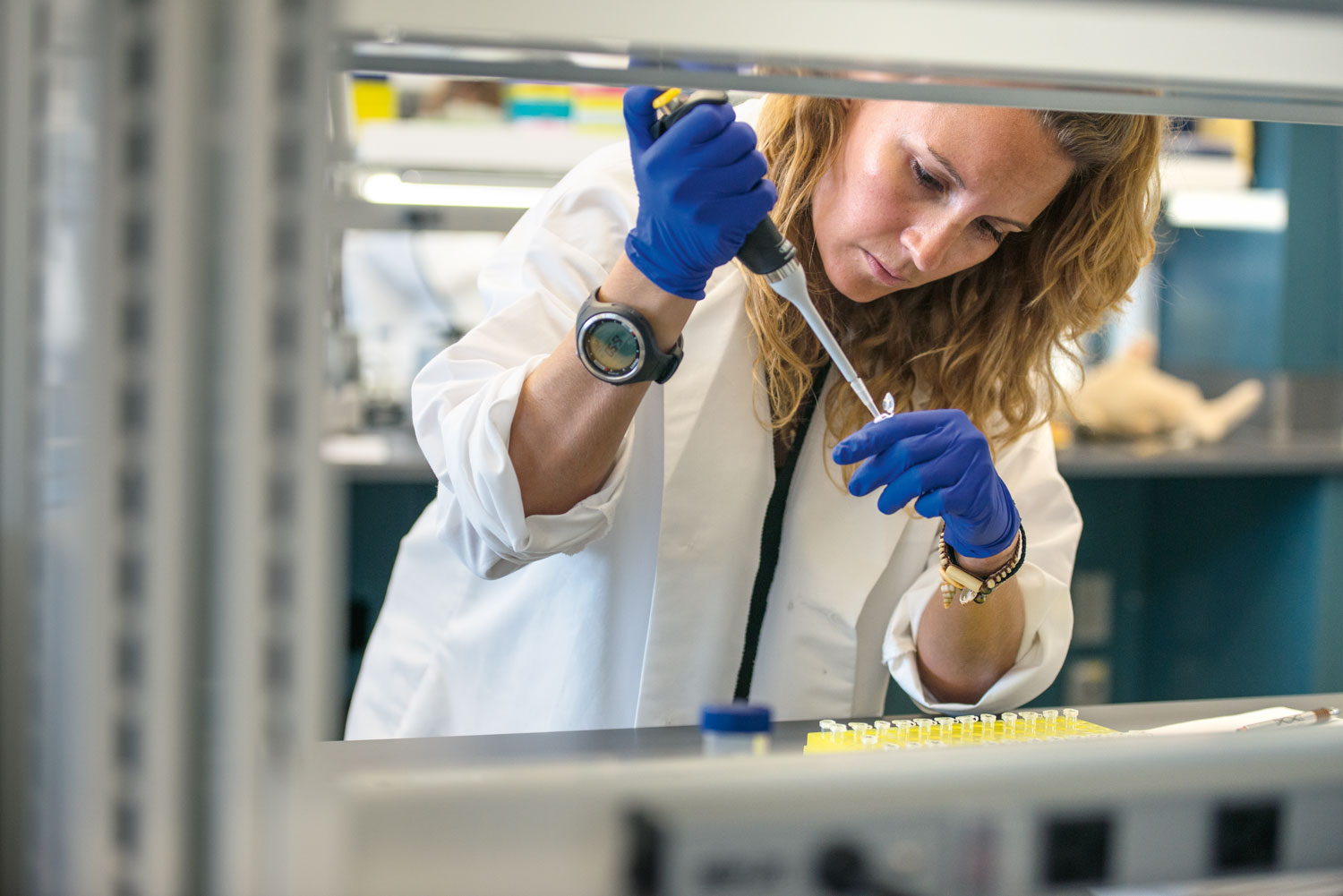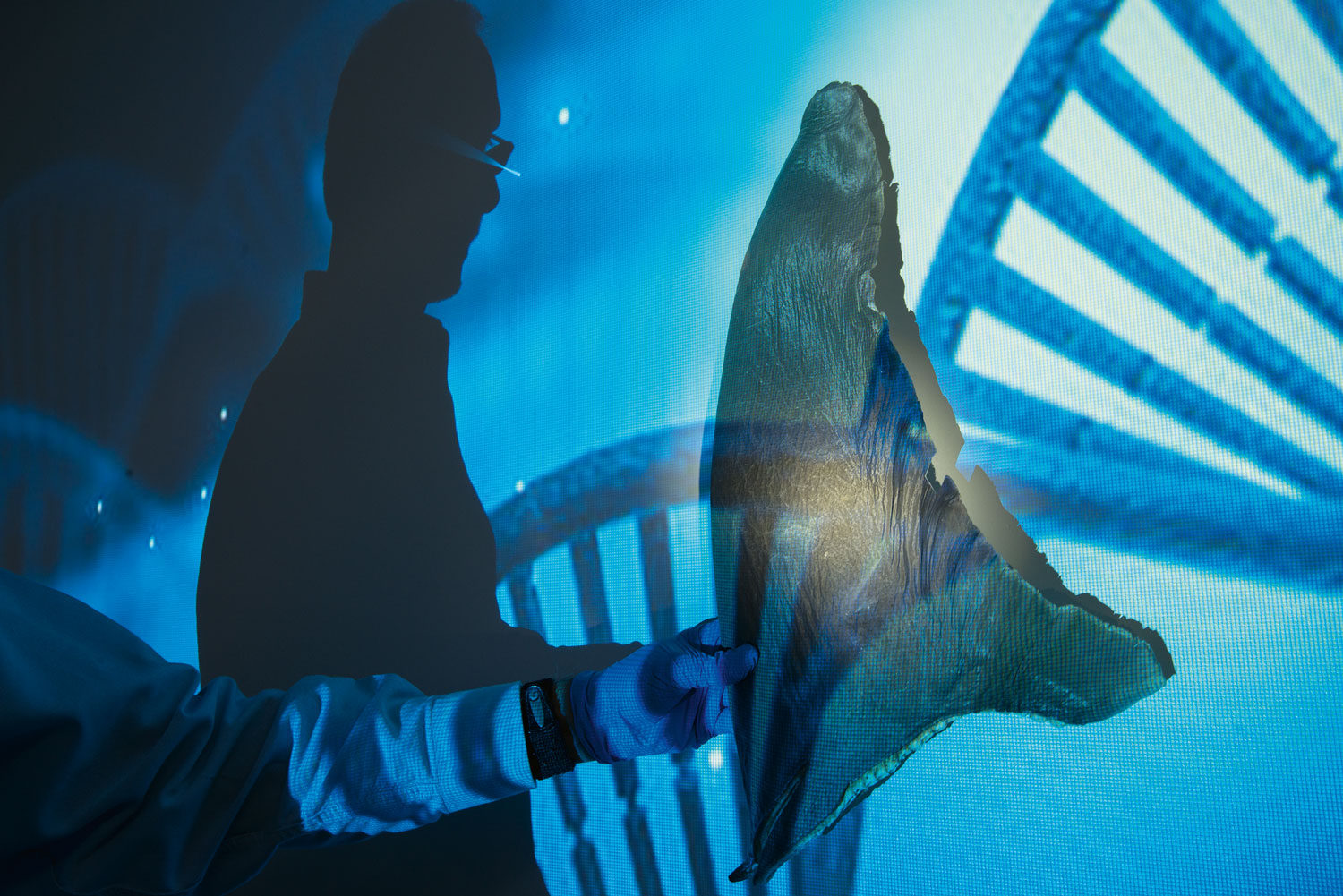DNA why it matters

Professor Mahmood Shivji is director of the Save our Seas Foundation Shark Research Center, housed at Nova Southeastern University, Florida. Photo © Nova Southeastern University
In the past few years, most of us have had up-close encounters with genetic tests as the COVID-19 swab poked just a bit too far up our noses. The field of genetics is pushing into many parts of our daily lives, from genetically modified (GM) foods to the companies that offer to tell us how many Neanderthal genes we have, and it’s also revolutionising the way scientists study species in the wild – including sharks. A mako shark racing across the Atlantic or a sevengill shark nosing its way through a shadowy kelp forest may seem a long way from the lab-based scientists who decipher DNA. And yet many sharks are telling their stories of how the ocean is changing and what we need to do to help conserve them, all from the genetic codes hidden inside their cells.
For Professor Mahmood Shivji, director of the Save Our Seas Foundation Shark Research Center (SOSF-SRC), which is housed at Nova Southeastern University in Florida, it all began in the 1990s when he read a local newspaper article about shark fishing. Originally an ecologist by training, he had switched to genetics for his PhD but hadn’t yet worked with sharks. ‘Fisheries managers were saying that they had a really difficult time identifying the shark body parts that were coming in from fishermen,’ says Shivji. The practice back then was for fishers to catch sharks and cut off their head, fins and tail leaving just the torsos, which are known as logs. ‘I read that article and I thought DNA can figure this out.’
So, Shivji got in touch with a team of shark biologists and asked if they could send him samples of tissue they’d collected from known species of sharks. He used these to identify genetic markers, short sequences of DNA code that are unique to each species and can tell them apart. To test out these markers, Shivji asked the biologists to send him more samples, but not tell him which shark species they came from. ‘It worked,’ he says. This was the first time anyone had developed a genetic test for identifying shark species.
The workload burdened by the shark-fin trade on border officials was enormous; hopefully genetic solutions can act in tandem now with new CITES listings to reduce this load. Photo © South China Morning Post | Alamy
Jump forward to today and shark researchers have a huge genetic toolbox which they’re using to answer all sorts of questions. They can zoom in on intricate details or pan out and investigate sharks over huge swathes of space and time.
From a bucket of seawater, it’s now possible to sift tiny fragments of DNA which sharks leave behind in sloughed off skin cells and mucus. This environmental DNA or eDNA only lasts for a few days and can reveal which species recently swam by. Conservationists in Europe are using eDNA to identify important areas where critically endangered angel sharks still live, even if nobody sees them.
Shivji now uses DNA to gain a global view of sharks. He continues to work closely with fisheries managers and biologists who send him snippets of tissue from sharks they work with in the field. ‘Over the years, we’ve accumulated a really large collection of shark samples of different species from different parts of the world,’ he says. This catalogue is helping Shivji and colleagues draw genetic boundaries around shark populations and redefine our view of the otherwise borderless global ocean. They found, for instance, that tiger sharks are not all mingling and interbreeding with each other, even though they can migrate huge distances. Tiger sharks in the Atlantic don’t mix with those in the Indian and Pacific oceans. Tiger sharks that hang around Hawai’i are also genetically distinct from others. Likewise, broadnose sevengill sharks are genetically separate in the South Atlantic Ocean, the Eastern Pacific and Oceania. Night sharks prowl the deep waters of the twilight zone in at least two distinct groups in the Atlantic. The more species are studied, the more their genetics are showing just how divided and structured shark populations truly are.
This has major implications for shark conservation. Those regional populations need looking after separately rather than as global, cosmopolitan collectives. If, say, tiger sharks become overfished and depleted in the Atlantic, others from elsewhere are not going to come and help replenish their numbers.
Photo by Justin Gilligan | © Save Our Seas Foundation
With DNA sequencing now much cheaper and more accurate than ever, scientists have begun decoding the entire genetic makeup, or genomes, of sharks. Recently, Shivji and colleagues sequenced for the first time the genomes of shortfin mako and great hammerhead sharks. Diving deep into the DNA of these animals has turned the scientists into time travellers. Based on variation in the genetic codes from just two individual sharks, they retraced the history of the species and inferred that the numbers of makos and hammerheads both drastically declined over the past quarter of a million years.
More worryingly, the great hammerhead genome showed very low levels of genetic diversity, a likely indication that the species is in big trouble and not well equipped to cope with climate change. ‘The more genetic diversity there is, the better,’ says Shivji. ‘That’s a fundamental principle in conservation.’ Variation within populations was the basis for Charles Darwin’s theory of evolution, allowing species to adapt to their surroundings. On the flip side, populations that lack diversity can be more prone to going extinct, especially when their environment is swiftly changing as the ocean is today.
The great hammerhead’s DNA also revealed it was highly inbred, likely because its population was very small – another sign of a species that’s not in great shape. ‘Great hammerheads need extremely urgent measures for their conservation,’ says Shivji. ‘Genetically they’re on their way out.’
The genome of the shortfin mako shark delivered more positive news. Its genetic variation was much higher than the great hammerhead’s. It seems there was a large enough population of shortfin makos in the past to help protect them from inbreeding and loss of diversity when humans came along and started hunting them. ‘This species is endangered,’ says Shivji, ‘but I think with proper management it has the potential to come back and restore its genetic diversity.’
TRACKING TRADE
Having begun his work with shark DNA identifying species from their dismembered torsos, Shivji also followed the genetic trail of their fins. For decades, the global trade in fins to make into soup has been a huge but poorly understood threat to shark populations. In the early 2000s, Shivji began collaborating with Shelley Clarke, then a PhD student at Imperial College London, to apply genetic tools to the puzzle of which species were involved in the shark-fin trade.
By the time shark-fins have been cut off, dried and bleached to an old-fingernail yellow, a lot of them are hard to tell apart by eye. Clarke was working in Hong Kong, the world’s largest shark-fin market, visiting wholesalers and gathering samples of fins from huge shipments as they were being sorted for sale in auction houses. Back in the lab, Clarke and Shivji used genetics to match up the Chinese names given to fins sold in the marketplace with specific shark species. ‘I ended up developing a very rapid test that didn’t require DNA sequencing,’ says Shivji. Instead he used a much faster, streamlined method, similar to PCR tests for COVID-19. These tests showed that blue sharks were the most common species being traded, followed by shortfin mako, silky, dusky, sandbar and tiger sharks.
Photo above © Nicolas Job | The Ocean Agency
Twenty years later, Diego Cardeñosa from Florida International University continues to monitor the global fin trade via the marketplace in Hong Kong. Instead of buying whole fins, members of his team visit the market once a month, randomly select 10 dried seafood vendors out of around 300, and buy from each of them a cheap bag of trimmings that are snipped off fins to neaten the edges.
Cardeñosa picks out 10 pieces from each bag and runs genetic tests to identify the species. ‘It gives us a unique perspective on shark-fin trade dynamics,’ says Cardeñosa. ‘If something happens in trade and one species starts being traded more, or disappears from trade, we will quickly notice that change.’
So far, the Hong Kong surveys show that not a lot has been changing in the fin trade, despite better protection for sharks. In 2003, whale sharks and basking sharks were the first chondrichthyan species added to CITES, a convention that oversees the international trade in endangered species. By 2017, the CITES list included another dozen endangered sharks that are prominent in the fin trade, including silky, hammerhead and thresher sharks. The trade in these species hasn’t been banned, but it’s regulated. Nations signed up to CITES must provide paperwork certifying the animals were caught without depleting wild populations. The Hong Kong surveys suggest that CITES-listed shark species are still being traded illegally without the necessary permits. ‘We found that CITES-listed species were an order of magnitude more common than they should be,’ says Cardeñosa.
Hong Kong is the bustling hub of shark trade and traffic, as the largest importer of shark fins in the world. Photo © Leungchopan | Shutterstock
Then in 2022, his team released a shocking study. They had found that two thirds of the species showing up in their genetic tests of fin trimmings were threatened with extinction. Most of these were on the same list of oceanic, wide-ranging species that Clarke and Shivji had identified, which have the biggest most valuable fins. Cardeñosa also detected a smaller but still significant proportion of fins from endangered species that live along coastlines and have a more restricted range, species like blacknose sharks, pig-eye sharks and sicklefin lemon sharks. As Cardeñosa pointed out, there was a big gap in the way sharks were being managed and in many places these coastal species were flying under the radar with no regulations in place to protect them.
A few months after that study came out, the latest round of CITES negotiations took place in Panama. Up for discussion was the most ambitious list of sharks to date. Dozens more species were put forward for trade regulations: guitarfish, several hammerhead sharks and the entire family of requiem sharks including many of the coastal species Cardeñosa’s team had identified as needing protection.
The vote went ahead and all the shark proposals were adopted. ‘We think [the study] really helped to make the decision in favour of the listing of those species,’ he says.
The decision marks what Cardeñosa hopes will be a turning point in the shark-fin trade. Now almost 90 per cent of traded fins are from CITES-listed species, which should make enforcement more straightforward. Customs officers can now assume that every container coming into Hong Kong holds some CITES species and needs to be accompanied by a permit. Shipments without permits are probably illegal. They still need to be checked, which is where another part of Cardeñosa’s work comes in. His team has developed a mobile shark DNA lab that can be taken to a container of fins and used on site to identify the species inside.
The votes at CITES COP19 in 2022 brought about much-needed change in shark policy, with 90% of the fin trade brought under regulation by the new listing of species. Photo © Toby Matthews | The Ocean Agency
The mobile lab requires a small investment in equipment up front, then it costs only a dollar to run a sample. Critically, the entire process is fast. Depending on the country, customs officers may only have a 24 or 36-hour window to provide evidence of an illegal shipment of protected wildlife. Previously, it could take a week or more to send tissue samples off to a lab for analysis. Now Cardeñosa is training customs officers to do the forensic analyses themselves and get results within a few hours. ‘It’s just like making a little cocktail,’ he says. ‘You don’t need to be a lab technician, and you don’t need to have a degree in biology or genetics to do it.’
Other endangered species besides sharks can be identified in a mobile lab. Cardeñosa was involved in the first conviction of eel smugglers in Hong Kong after he helped identify the strictly protected European species in a consignment of wriggling juvenile eels. ‘You can make as many laws as you want, but if you cannot enforce them, then they’re just paper laws,’ he says.
Many countries are already using mobile DNA labs to monitor the shark-fin trade, including Belize, Panama, Brazil, Peru, Ecuador and Spain. Cardeñosa is confident more will join them as CITES regulations come into force. ‘I think countries now are going to really need these kinds of tools to get all the evidence they need,’ he says.
In the meantime, Cardeñosa’s team will continue their surveys of the trade in Hong Kong. ‘The long-term data set that we’re collecting is really valuable for setting new policies and assessing the compliance of previous ones,’ he says. He also plans to track where illegally traded shark fins are coming from. Based on genetic variations from place to place within a species, it’s now possible to work out where sharks were caught and to pinpoint areas of the world where more help is needed to monitor and control the trade. ‘The good thing with genetics is that every time you find something it leads you to more answers,’ he says.



